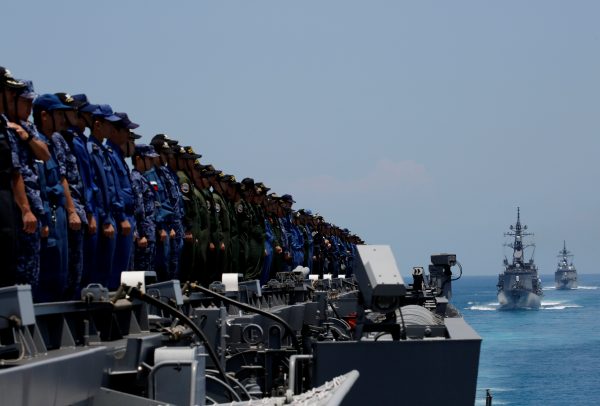India, Japan and the United States held their first trilateral meeting (coined the JAI grouping) on the sidelines of the December 2018 G20 summit in Buenos Aires. The leaders of the three countries agreed that a ’free, open, inclusive and rules-based’ order is essential for the Indo-Pacific’s peace and prosperity.
The United States emphasises the power dynamics underlying the FOIP while Japan highlights its economic potential. To Japan, the FOIP is open to all countries that observe the rule of law, freedom of navigation and relevant standards of transparency and sustainable development.
While stressing that no one is excluded, the United States aspires to a regional order of independent nations in the Indo-Pacific that defends its populations, respects human dignity, competes fairly in the marketplace and is free from great power domination. Given US criticism or suspicion of China in most of these areas, it may not be easy for China to be part of the FOIP even if Beijing wished to be included.
The JAI grouping is shaping up to play a key role in Indian foreign policy. India proposes the three countries synergise their infrastructure projects and other efforts in the region. Tokyo and New Delhi have already agreed to deepen naval and maritime security cooperation and collaborate on infrastructure projects in third countries, including Myanmar, Bangladesh and Sri Lanka, to enhance strategic connectivity in the Indo-Pacific.
Assuring all countries that the FOIP will be open and inclusive, Prime Minister Narendra Modi articulated five areas for greater cooperation and advancement that would serve the common interest of promoting peace and prosperity in the Indo-Pacific: connectivity, sustainable development, maritime security, disaster relief and freedom of navigation. Modi also underlined the importance of building consensus on a regional architecture based on principles of mutual benefit and respect for sovereignty and territorial integrity.
While stakeholders have a broad agreement on the FOIP’s principles, what needs to be discussed next is their implementation. Without addressing the question of implementation and lacking clarity on the specifics, countries in the region including ASEAN will continue to remain hesitant to embrace the FOIP concept.
ASEAN member states show different levels of scepticism about the FOIP. The Philippines and Cambodia were initially the most reluctant to discuss the initiative within the ASEAN framework, fearing it might hurt ASEAN centrality, while Laos, Brunei and Myanmar were silent. They became more receptive to discussions as more information became available. Indonesia, Vietnam, Thailand, Singapore and Malaysia seem to be supportive of the initiative although each of them would like to shape it according to their respective strategic interests.
Washington and New Delhi frequently reiterate that ASEAN centrality is key to the FOIP as it embodies regional inclusivity and multilateral trade. ASEAN already has a set of interlinking regional mechanisms such as the East Asia Summit, ASEAN Regional Forum and ASEAN Defence Ministers Meeting Plus, designed to engage major powers and neighbouring countries.
The FOIP framework should make use of these existing mechanisms to ensure that the region has complementary rather than competing mechanisms. For instance, ASEAN can engage its ASEAN Maritime Forum to complement efforts by the Indian Ocean RIM Association and the Indian Ocean Naval Symposium.
ASEAN can also engage BIMSTEC as an economic sub-grouping in the Bay of Bengal involving Bangladesh, India, Myanmar, Sri Lanka, Thailand, Nepal and Bhutan, especially since two of the BIMSTEC members (Myanmar and Thailand) are also members of ASEAN. BIMSTEC’s connectivity projects in the Bay of Bengal region would greatly benefit from ASEAN’s involvement.
To get ASEAN on board with the FOIP concept, it is essential the grouping plays a role in defining the evolving regional security architecture. Indonesia has been the most active among ASEAN member states in articulating its version of the FOIP and is finalising an ASEAN concept paper on the Indo-Pacific.
Although the concept paper is still being drawn up, ASEAN diplomats have alerted dialogue partners that the ASEAN framework will not toe the line of the US-inspired strategy despite some overlap on key principles. It will be inclusive and not aimed at any particular power. It will also come with practical measures and action plans. ASEAN aims to synergise elements of Washington, Tokyo and New Delhi’s concepts with ASEAN-led projects concerning infrastructure development, governance and maritime cooperation.
As different states have different understandings of the FOIP, it is critical to ensure that the concept does not create misunderstandings. There is a need to continue engagement with ASEAN member states and other regional stakeholders so that all actors are on the same page, particularly with Australia, India and Indonesia heading into electoral campaigning in 2019.
Nazia Hussain is a Research Analyst in the Office of the Executive Deputy Chairman, S Rajaratnam School of International Studies (RSIS), Nanyang Technological University, Singapore.
A version of this article originally appeared here on RSIS.

